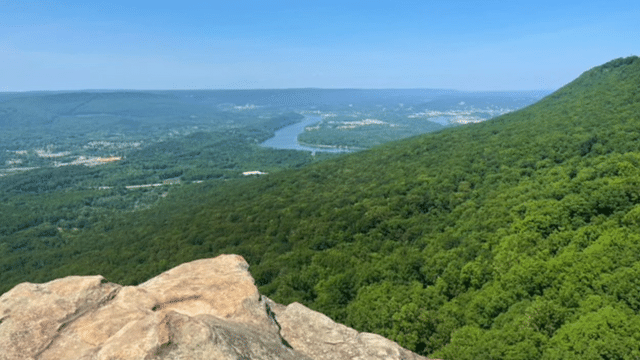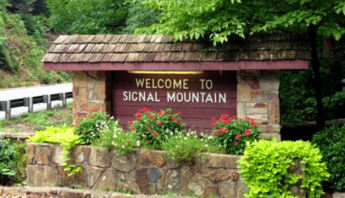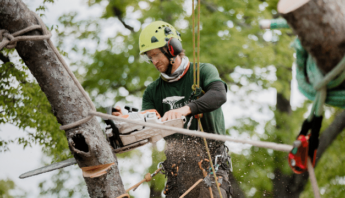Lookout Mountain has been drawing visitors and residents alike for decades thanks to the infamous attractions of Rock City and Ruby Falls. The historical Point Park and Sunset Rock atop the mountain has numerous stunning overviews, which only stay stunning if they are protected and the trees cared for on the surrounding properties.
Today we continue our series about identifying and caring for trees throughout the Tennessee Valley with a focus on Lookout Mountain.
Here’s a breakdown of the populous trees on our famed mountain that splits Georgia and Tennessee state lines including how to identify each tree type and ways to spot issues so you can get them treated, pruned or removed before that tree becomes a bigger problem.
Native Tree 1: Oak Trees
When you think about the real estate on Lookout, you often conjure the image of a beautiful property with a huge tree in the front lawn (or back providing shade to families.) Those trees are usually oak and can be more than 100 years old. Pruning these mommoths is imperative to keep them healthy for another 100 years (or more!)
Identifying an Oak Tree
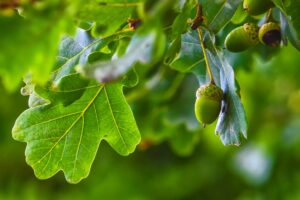 Want to spot an oak tree quickly? Look for acorns either in the branches or on your lawn. Oaks are the only trees in our area whose fruit (yes it’s called a fruit in tree terms even though it’s not a banana kind of fruit) is an acorn.
Want to spot an oak tree quickly? Look for acorns either in the branches or on your lawn. Oaks are the only trees in our area whose fruit (yes it’s called a fruit in tree terms even though it’s not a banana kind of fruit) is an acorn.
Second identifier: the shape of the leaves. Oaks are a simple, one-leaf shape design as opposed to the multiple leaflets that you’ll see on other trees we’ll discuss in a minute.
Identifying Issues with Oak
Oaks are great for providing a ton of shade to your outdoor activities. This requires long branches and often, a lot of them. However, if those branches are starting to sag towards the ends of the overall top of the tree, a.k.a. the canopy, looks a bit “womp womp” then your oak has overextended branches. This is a sign you need to get it pruned.
Another sign: dead branches towards the top. Even if the rest of the tree looks healthy, dead branches in the canopy is a tree’s cry for help.
Native Tree 2: Hemlock Trees
Often mistaken as pine trees for their similar style of needs, hemlock trees thrive in the higher elevations and near water like creeks, lakes and rivers. If you’ve seen a salamander or two near your home, chances are there is water nearby and a hemlock isn’t far away. Small aquatic creatures love the shade provided by the hemlock.
Identifying a Hemlock
The quickest way to differentiate a hemlock from a pine tree is to flip over the branches. Hemlocks have flatter needles with a distinctive white stripe on the underside. (This identifying technique will also come in handy when trying to spot any issues with your hemlock.)
Spotting Issues with Hemlock
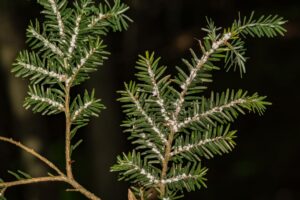 As with oak trees who tend to show their signs of poor health from the top down, hemlocks also start thinning out at the canopy first when something is wrong.
As with oak trees who tend to show their signs of poor health from the top down, hemlocks also start thinning out at the canopy first when something is wrong.
Additionally, they are prone to infestations during the fall to late spring months. Keep an eye on your hemlocks and regularly flip those branches over to look for cotton-like white masses on the underside. Unlike the white stripes that are supposed to be there, the masses are a sign your tree needs an insecticide treatment by an arborist.
Native Tree 3: Ash Trees
Ash trees may sound like they should be, well ashen, in color but don’t let the name fool you. These trees boast wonderful shades of green throughout the non-winter months meaning you’ll need to look a little closer to spot them among the other trees on your property.
How to Identify an Ash Tree
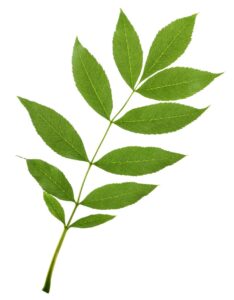 Start by looking at the leaves. Ash trees have what is known as compound leaves, meaning a single leaf can have as many as nine leaflets growing from its stem.
Start by looking at the leaves. Ash trees have what is known as compound leaves, meaning a single leaf can have as many as nine leaflets growing from its stem.
Next, check out the way the branches grow. Ash sports what is known as an opposite arrangement, though could easily be renamed to a mirror arrangement if you ask us. Whatever the length of a branch is on one side, a branch of an exact duplicate length will be on the other – like a mirror image of each other.
Spotting Problems with Ash Trees
As with the other trees we’ve discussed so far, identifying a problem with an ash tree begins by looking at the canopy. If you notice the trips of the branches towards the top of the tree starting to die or wilt, then it’s time to call in the experts for some nutrient treatments and pruning of the dead wood.
The dead wood is often a sign of infestation by the emerald ash borer that can eat away at the tree until it’s so unstable the threat of it falling down, and causing an insurance liability for you, becomes a near guarantee.
Now through September is the best time to treat these buggers.
Native Tree 4: Maple Trees
Just like oak trees, which you can find all over the Chattanooga region, maple trees are populous and have four predominant species around here: red, silver, sugar and box elder.
Identifying a Maple Tree
All those stunning orange, gold, and red colors that make the drive up Lookout Mountain so beautiful in the fall months is a credit to the abundant maple trees.
If you’re looking to spot them outside of the fall months, look for a tree showcasing single leafs, unlike the abundant leaflets of the ash tree, with multiple points on it.
And if that’s not enough clarity, think of the image emblazoned on all syrup bottles. That’s a maple leaf.
Recognizing Problems with Maple Trees
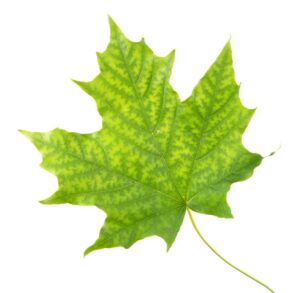
Maple leaf with chlorosis
There are two primary ways to spot an issue with a maple tree:
Yellowing leaves that should be green given the time of year. This is known as chlorosis, which is caused by a lack of nutrients reaching the leaves through the tree trunk and branches.
Girdling roots, or rather roots that come up above ground at the base of the tree. Your children may love to jump around these when playing outside but they are a clear indicator that the tree is unable to absorb the nutrients all the way up the trunk due to the additional pressure on the roots. If left untreated, this can slowly kill the maple.
Have you seen any of these issues with the trees along your Lookout Mountain property?
Make an appointment with our arborists to come evaluate the situation and create a customized treatment plan to keep your tree beautiful and property hazard-free.


